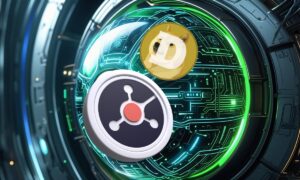Welcome to the digital art revolution! In a world where memes rule social media feeds and viral videos dominate online platforms, it’s no surprise that digital creations have become a hot commodity. But what if we told you that these seemingly ephemeral pieces of content could now be transformed into masterpieces worth millions? Enter NFTs, the game-changer in the realm of art valuation. From famous artworks to internet sensations, this groundbreaking technology is reshaping how we perceive, buy, and sell digital art. Join us as we dive deep into this fascinating phenomenon and explore how NFTs are redefining the value of artwork like never before.
Introduction
The world of digital art has undergone a massive transformation with the introduction of non-fungible tokens (NFTs). These unique digital assets have taken the art market by storm, making headlines for their record-breaking sales and redefining the concept of ownership in the digital space. But what exactly are NFTs, and how do they impact the value and future of digital art?
NFTs, or non-fungible tokens, are a type of cryptocurrency that represents a one-of-a-kind asset on a blockchain network. Unlike traditional cryptocurrencies like Bitcoin or Ethereum, which are interchangeable and hold equal value, each NFT is completely unique and holds its own distinct value. This makes them perfect for representing digital assets such as artwork, music, videos, or even tweets.
The concept of non-fungible tokens and how they work
Non-fungible tokens, or NFTs, have been making headlines in the world of digital art. But what exactly are they, and how do they work? In this section, we will delve into the concept of non-fungible tokens and explore their role in revolutionizing the value of digital art.
To understand NFTs, it is important to first grasp the idea of fungibility. Fungibility refers to the interchangeability and equal value of goods or assets. For example, a dollar bill is fungible because it can be exchanged for another dollar bill and its value remains the same. On the other hand, a unique painting by a renowned artist is non-fungible because it cannot be replaced with an exact replica; each piece has its own distinct value.
NFTs take this concept of non-fungibility into the digital world. They are unique digital assets that cannot be replicated or replaced with something else. Unlike traditional cryptocurrencies like Bitcoin, which are interchangeable, each NFT holds its own distinct characteristics that make it one-of-a-kind and irreplaceable.
NFTs operate on blockchain technology, a decentralized ledger system that records transactions securely and transparently. Each NFT is assigned a unique code called a “token ID,” which verifies its authenticity and ownership. This token ID also contains information about the asset, such as its creator, date of creation, and any other relevant data.
The history of NFTs and their evolution in the art world
The concept of non-fungible tokens (NFTs) may seem like a relatively new phenomenon, but the history of these unique digital assets can be traced back to the early days of the internet. In fact, the origins of NFTs can be found in the world of online gaming and virtual currencies.
During the late 1990s and early 2000s, online games such as Second Life and World of Warcraft created their own virtual economies where players could buy and sell digital goods using in-game currencies. These virtual items, often referred to as “skins” or “avatars,” were seen as valuable by players who were willing to spend real money on them.
As technology continued to advance and social media platforms emerged, people began creating and sharing digital content more than ever before. This brought about a new era for NFTs as artists started exploring ways to monetize their work in digital form.
One significant milestone for NFTs was in 2012, when American artist Kevin McCoy created an artwork called “Quantum” and registered it on the blockchain, making it one of the first instances of a tokenized asset. However, at that time, NFTs did not gain much attention or traction outside of tech circles.
It wasn’t until 2017 when CryptoKitties, an Ethereum-based game that allows users to buy, collect, breed, and trade unique digital cats using NFTs, gained massive popularity.
How NFTs are changing the value and ownership of digital art
NFTs, or non-fungible tokens, have taken the art world by storm in recent years. These unique digital assets are revolutionizing the way we perceive and assign value to digital art. In this section, we will delve into how NFTs are changing the game for digital artists and collectors and redefining the concept of ownership in the world of art.
Firstly, it is important to understand what exactly an NFT is. In simple terms, it is a unique token that represents ownership of a specific asset on a blockchain network. This means that each NFT is one-of-a-kind and cannot be replicated or exchanged for another asset like traditional cryptocurrencies. This scarcity adds to their value and makes them highly sought-after by collectors.
One of the main ways in which NFTs are changing the value of digital art is by providing a way for artists to monetize their work directly. Before NFTs, digital art was often seen as less valuable than physical artwork because it could easily be copied and shared without any financial benefit to the original creator. With NFTs, artists can now attach a unique token to their artwork and sell it as a limited edition piece with proof of ownership on the blockchain.
This has opened up new opportunities for digital artists who were previously struggling to make a living from their creations. They can now set their own prices for their work without having to go through galleries or other intermediaries, keeping more control over their earnings and creative process.
Criticisms and controversies surrounding NFTs
NFTs, or non-fungible tokens, have been making waves in the art world as a new way to buy, sell, and collect digital art. However, like any emerging technology or trend, they have also faced their fair share of criticisms and controversies.
One of the main criticisms of NFTs is their environmental impact. The process of creating an NFT requires a significant amount of energy consumption due to the use of blockchain technology. This has led to concerns about the carbon footprint and sustainability of NFTs. In fact, according to a report by Memo Akten for Art Basel’s Global Art Market Report 2021, each transaction on the Ethereum blockchain used for NFTs generates approximately 35 kilograms (77 pounds) of CO2 emissions.
Another issue surrounding NFTs is their potential for fraud and scams. Since anyone can create and sell an NFT, there have been instances where artists’ work has been stolen or replicated without their permission and sold as an NFT. This has raised questions about the authenticity and ownership of digital art in the world of NFTs.
Moreover, some critics argue that NFTs contribute to financial speculation rather than supporting genuine artistic value. With some pieces selling for exorbitant prices—even reaching millions of dollars—it raises concerns about whether these prices are driven by true appreciation for the artwork itself or simply as a means for investors to make a profit.
Potential applications beyond art in the future
In recent years, non-fungible tokens (NFTs) have gained significant attention in the art world as a new way to buy and sell digital artwork. However, the potential applications of NFTs go far beyond just the art industry. With their unique features and capabilities, NFTs have the potential to revolutionize various industries and change the way we perceive ownership, authenticity, and value.
One of the most promising areas where NFTs could have a major impact is in gaming. Currently, many video games use in-game currencies or items that are owned by the game developers and cannot be transferred or sold outside of the game ecosystem. However, with NFTs, these items can be tokenized and traded on a decentralized marketplace, allowing players to truly own their virtual assets. This not only gives players more control over their gaming experience but also opens up new opportunities for creators to earn money through their designs.
Another area where NFTs could have a significant impact is in collectibles. Physical collectibles such as trading cards or limited edition toys often come with authenticity issues and high production costs. With NFTs, these objects can be digitized and tokenized with unique identifiers that prove their authenticity while reducing production costs. This also allows for easier trading and tracking of ownership for both collectors and sellers.
Conclusion
The rise of NFTs has sparked a new era in the world of digital art, challenging traditional notions of ownership and value. As we have explored throughout this article, NFTs offer a unique opportunity for artists to truly own and monetize their digital creations.



































